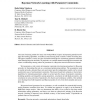IJAR
2007
14 years 7 months ago
2007
The use of several types of structural restrictions within algorithms for learning Bayesian networks is considered. These restrictions may codify expert knowledge in a given domai...
ML
2008
ACM
14 years 7 months ago
2008
ACM
The use of Bayesian networks for classification problems has received significant recent attention. Although computationally efficient, the standard maximum likelihood learning me...
JMLR
2006
14 years 7 months ago
2006
In recent years, there has been a growing interest in applying Bayesian networks and their extensions to reconstruct regulatory networks from gene expression data. Since the gene ...
JMLR
2006
14 years 7 months ago
2006
The task of learning models for many real-world problems requires incorporating domain knowledge into learning algorithms, to enable accurate learning from a realistic volume of t...
IPL
2008
14 years 7 months ago
2008
Bayesian Network structures with a maximum in-degree of k can be approximated with respect to a positive scoring metric up to an factor of 1/k. Key words: approximation algorithm,...
IJAR
2006
14 years 7 months ago
2006
Probabilistic decision graphs (PDGs) are a representation language for probability distributions based on binary decision diagrams. PDGs can encode (context-specific) independence...
IJAR
2006
14 years 7 months ago
2006
We consider the problem of learning the parameters of a Bayesian network from data, while taking into account prior knowledge about the signs of influences between variables. Such...
BMCBI
2006
14 years 7 months ago
2006
Background: A number of methods that use both protein structural and evolutionary information are available to predict the functional consequences of missense mutations. However, ...
BMCBI
2008
14 years 7 months ago
2008
Background: Genes interact with each other as basic building blocks of life, forming a complicated network. The relationship between groups of genes with different functions can b...
BMCBI
2010
14 years 7 months ago
2010
Background: Mocapy++ is a toolkit for parameter learning and inference in dynamic Bayesian networks (DBNs). It supports a wide range of DBN architectures and probability distribut...





